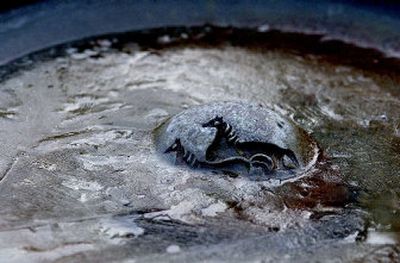Prepare water features, ponds for winter

For those of you who have water features and ponds, it’s time to prepare them for the cold weather. A little bit of time now could save your investment later.
Small, above-ground fountains and container water gardens.
Ralph McGowen of the Inland Empire Water Garden and Koi Society recommends small above-ground fountains and water gardens be drained and covered with plastic, especially those made of clay, ceramic or concrete. Water expands when it freezes, and that can fracture even weather-proof ceramics. Remove pumps and piping, drain them completely.
Remove plants and fish from these containers. Fish can be brought into an indoor aquarium while plants in their pots can be placed in tubs of water in a well-lighted, cool room. Water hyacinth and water lettuce are better treated as annuals.
Small, shallow, in-ground water features and ponds.
Containers less than 2 feet deep need to be drained, and plants and fish removed and brought indoors. Check the winterizing instructions that came with your pond and pump kit for details. Remove and drain pumps and plumbing.
Large ponds
Ponds that are 2 feet deep or more can be winterized. Clean out any leaf and tree debris that has fallen into the water before it decays over winter and produces ammonia, methane and carbon monoxide, all of which are deadly to fish. Follow the manufacturer’s recommendations on winterizing your pumps, filters and plumbing.
Hardy pond plants go dormant when the water goes below 50 degrees. Trim back foliage and move to the deepest part of the pond. Tropical plants like elephant ears, tropical lilies and cannas need to be removed after the first frosts and stored indoors as noted above. Reeds, rushes and other edge plants can be left in place.
Fish in winter
Koi need 3 feet of water and goldfish 2 feet to survive the winter. Their metabolism slows once the water reaches 50 degrees putting them in a suspended state. They survive at the bottom of the pond where the water doesn’t generally freeze. This is because water is the densest, thus the heaviest, at a balmy 39 degrees. “If you have a waterfall, you want to shut that off,” said McGowen. Leaving it running super cools the water and disturbs this temperature balance.
Even when dormant, fish need access to air to disperse built up gases and add oxygen back into the water. Use a pond de-icer to open a hole in the ice then place a small, 4- to 7-watt aquarium pump near the water’s surface to circulate the water enough to enhance gas exchange but not enough to disrupt the temperature balances at the bottom of the pond. If the hole closes, melt a new one with a pan of hot water. Never pound a hole with a tool as the shock waves can hurt the fish.
Because the devil is in the details, check with your favorite pond expert on the particulars of winterizing your water feature and pond.